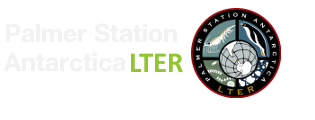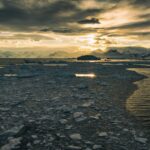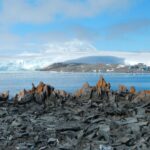An Inlet By Any Other Name: Lamont Scientist Honored with Antarctic Feature Name
A bay in Antarctica has been named after biological oceanographer Hugh Ducklow from Columbia University’s Lamont-Doherty Earth Observatory.
The name — made official in October — recognizes the oceanographer’s “extensive, noteworthy, and exemplary contributions to the advancement of marine biology in Antarctica,” as well as his 16 years of leadership at Antarctica’s Palmer Station.
The newly named Ducklow Inlet is small, treacherous, and pivotal to reaching an Antarctic island called Charcot, where few scientists other than Ducklow and his team have set foot.
Left: Map showing the location of Charcot Island in Antarctica. Right: Closeup of Charcot Island. The newly named Ducklow Inlet is located on the northwest side of the island. Images: Google Maps
Ducklow leads the Palmer Antarctic Long Term Ecological Research team, investigating the Antarctica’s response to climate change. But in 2009, the team’s usual research area had been so strongly influenced by global warming (including seeing an 80 percent decline in the penguin population), that Ducklow realized that he and his team needed to observe a region less influenced by warming and ice loss to better understand the impacts of climate change. They decided on Charcot Island, which is much further south than the range of their annual research cruises.
“We knew that an ice shelf had broken up there but it was covered by ice all year, and there was an old, brief report that there was an Adelie penguin colony there, and we wanted to try and find it, to get observations on the Adelies in their more typical habitat (less warmed, more ice),” said Ducklow.
Getting to Charcot involved a difficult journey — so difficult that the team failed to get to the island on their first try in 2009 because it was so heavily blocked by sea ice and small tabular icebergs. However, they did make it during a later attempt that year and confirmed the presence of the penguins. To Ducklow’s knowledge it was the first time anyone had been on the island in at least 20 years. (Their successful trip to Charcot Island is chronicled in a film called “Antarctic Edge: 70 South.”) Since that first successful landing, they’ve tried each January to cross the ice-laden sea and inlet to return to Charcot Island. They only made it again in 2010.
Ducklow and his team’s first expedition to Charcot confirmed that the island is still home to a colony of Adelie penguins. Photo: Hugh Ducklow
Two months ago, Ducklow received word that a colleague was nominating the longtime scientist to have a landscape feature named for him. What place in Antarctica would Ducklow like to have as a namesake?
“We had to locate some feature that was unnamed, and relevant to our work,” Ducklow explained. “Generally the smaller a feature, the more possibility it will not already be named.” The inlet at Charcot Island—where Ducklow had spent so much time leading research teams—was the appropriate choice.
How great an honor is it for Ducklow? “Mostly it’s just kind of fun,” he said. “I think that Antarctic scientists always think about the possibility, because we all know colleagues, including others at Lamont, who have features named for them. If I could, I would nominate every student we have taken to Antarctica in my research team.”
“I think my inlet is probably the smallest feature named after a Lamonter,” he added.
There are several land features named for Lamont scientists. Here is a partial list. Media Inquiries: Marie DeNoia Aronsohn
marieda@ldeo.columbia.edu
845-365-8151



 This site was developed with the support of the National Science Foundation under Grant No. OPP-2224611 and OPP-2026045. Any opinions, findings, and conclusions or recommendations expressed in this material are those of the authors and do not necessarily reflect the views of the National Science Foundation.
This site was developed with the support of the National Science Foundation under Grant No. OPP-2224611 and OPP-2026045. Any opinions, findings, and conclusions or recommendations expressed in this material are those of the authors and do not necessarily reflect the views of the National Science Foundation.
